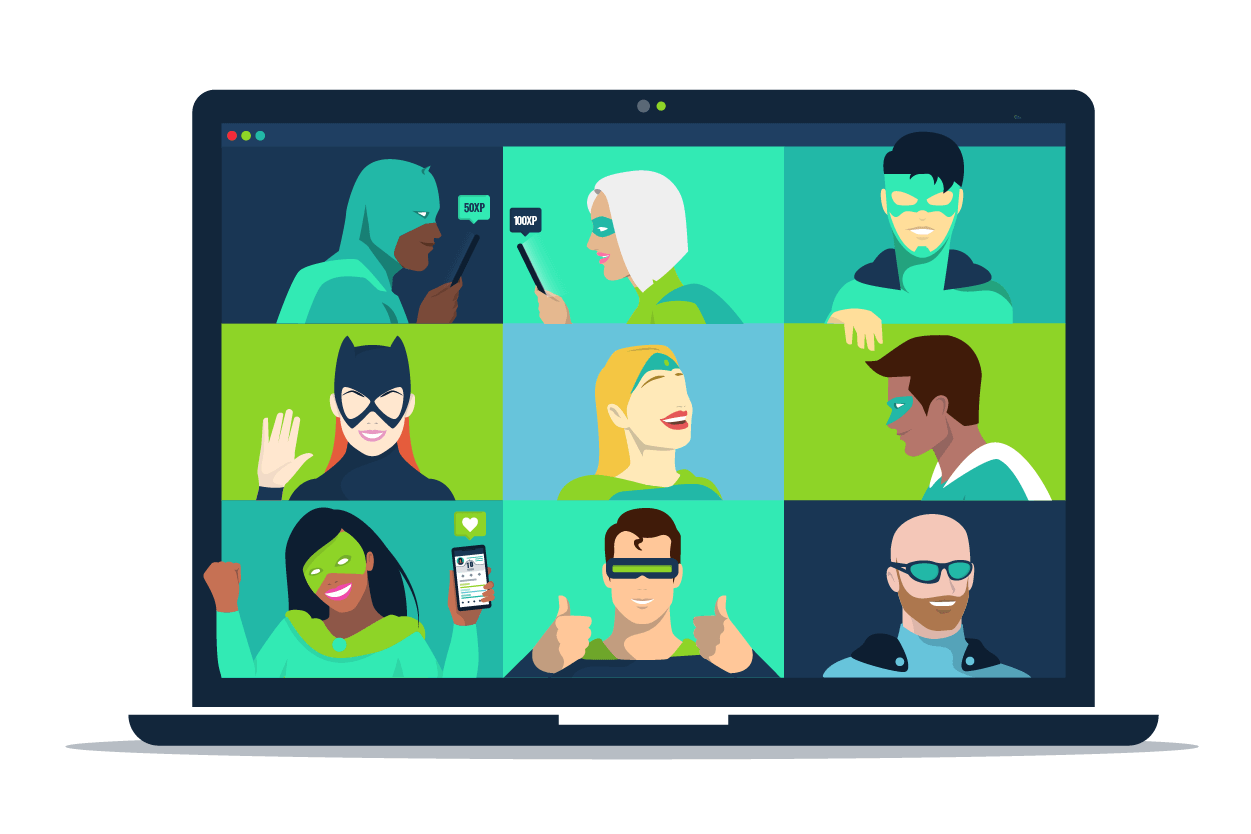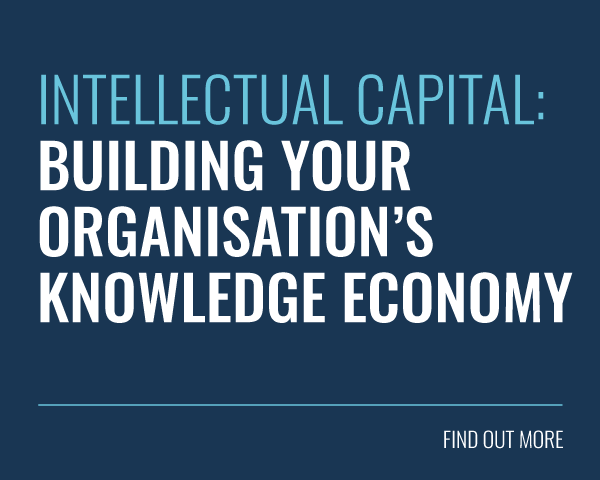 If you’re a trainer or an L&D professional, there’s a good chance you’re not delivering training to just one person. Although if you are, we really admire your efforts and dedication!
If you’re a trainer or an L&D professional, there’s a good chance you’re not delivering training to just one person. Although if you are, we really admire your efforts and dedication!
With all of your learners working their way through your training content, it’s only natural that they will want to let the world know about how amazing it is. Giving your learners the means to communicate and collaborate will let them discuss their learning journey and share knowledge of the topics at hand. This will help them to think about the content in ways they may not have even considered.
But is it worth investing in and encouraging social learning? Rest assured! We know it is. Social learning is the best way to squeeze a lot more out of your training programme while getting a soaring return on your training investment (ROI)!
What Makes Social Learning So Effective?
Today’s learning management systems (LMSs) embrace social learning as an avenue to increase engagement and improve training outcomes. With this ever-advancing technology, you can easily create learning communities that help your organisation generate a better return on your training investment.
Take our learning management system, The Academy LMS, as an example! It is packed full of social features. Learners can use features like Live Chat, Social Feeds, Groups, Clubs and the Experts Area to supercharge their informal learning intake.
With these kinds of tools, learning interventions no longer fly in a single direction. Instead, social learning fosters collaborative learning and knowledge-sharing. As such, it’s no wonder that the benefits of social learning are well-known!
But even though the benefits are clear, the pressure remains to measure return on investment for your learning. So, let’s explore a few of the ways social learning can maximise your ROI!
1. Building a Training Community

Every organisation is packed full of subject matter experts. Most of these are unsung heroes whose expertise is going to waste as they have no opportunities to share their knowledge. Luckily, with social learning, you’ll be able to tap into this goldmine of knowledge and share the wealth!
For instance, if John from the IT department wants to know more about your organisation’s lead generation efforts, he can simply strike up a conversation with Susie from Marketing. The perfect person to answer any questions is always within reach, providing endless scope for learning!
When your LMS is full of social learning features that help build an interactive learner community, your organisation can leverage subject matter experts and peer-to-peer discussions. This will help to spread knowledge across your organisation and enhance the learning experience.
Moreover, it provides a safe environment for discussion. You’re able to discuss ideas and information with your peers, rather than testing it out on the ‘frontline’ with sales prospects or customers. This can help you to fine tune your approach before utilising it on an external audience.
Brandon Hall Group research highlights that social learning approaches can deliver a 75:1 ROI ratio compared to formal training when it comes to unlocking and sharing knowledge. But social learning has the power to enhance your corporate culture as a whole. After all, 88% of workers prefer a collaborative environment to a competitive one.
2. Getting More Training for Your Buck
Social learning has the power to make your training community a hive of activity where everyone can learn from each other. But the real beauty of social learning is that your employees can continue their learning journey even after they’ve run out of content to consume!
With social learning, you can encourage user-generated content and spark discussion among your learners. As a result, you can keep your content creation costs at the same level while giving your learners more assets to draw information from. User-generated content won’t cost you a dime, which means that your investment doesn’t increase, but the return on investment certainly will!
When your learning content comes from experts within your workforce, there are no development or delivery costs as this knowledge is shared openly. As such, by promoting open dialogues, encouraging collaboration and fostering knowledge-sharing in your workplace, your organisation gets a happier and better-skilled workforce at little or no cost.
3. Slashing Engagement Costs

So, your training community is up and running, and everyone is talking about your learning programme. Well done! With so much buzz around it, there is no chance that people will forget about your learning programme anytime soon.
80% of learners say that working with people they like is highly motivating. Social learning enables them to get together to learn and collaborate, which increases engagement. And engaged learners absorb information quicker, helping to improve their performance, productivity and overall job satisfaction.
When your learners are engaged, you don’t need to spend as much time, money or resources trying to drag them back to your platform through engagement campaigns or constant push notifications. While these can be extremely effective ways to increase engagement, they also require time, attention and some of your training budget.
As such, creating a training community allows you to minimise your investment while maximising your return on investment. With this in mind, it’s easy to understand why 73% of companies expect to increase their focus on social learning!
4. Making Training Stick Better
According to the 70:20:10 framework, 20% of workplace learning happens when we interact with others. Only 10% happens through formal training, which makes social learning twice as effective! Even though the framework has faced some criticism, it helps us to understand just how important social learning is.
By giving your learners the tools they need to discuss their training, information starts to become ‘sticky’. When your learners interact with each other, they reinforce key learning points and encourage active participation.
Social learning helps to contextualise information discussed in formal training. Other learners can contribute real world examples of their training being put into action and the results this had. Video case studies on the learning platform social stream is a great way to do this!
It’s no wonder that 86% of employees say that collaborating with others helps them to learn the skills they need for their job. It can be a very effective way to increase productivity. For instance, Comcast achieved a 40% increase in productivity with social learning guided sales training! This resulted in a 60% year-over-year increase in sales
In addition, learning by teaching others is wildly effective. Learners who spend time training their peers show better understanding and knowledge retention than those who don’t.
As such, social learning leads to increased user engagement and a higher training ROI. After all, your learners have a new way of learning and are able to put their knowledge into action quicker.
5. Cutting Time-to-Productivity

Depending on the individual, feeling fully confident in your new role may take a long time. In fact, it has been estimated that reaching total productivity typically takes anything from 8 months to 2 years.
Luckily, social learning can accelerate this process! With social learning features and a collaborative learning culture, you can encourage new hires to ask their peers and internal subject matter experts questions. A social learning culture can help new employees create connections across the entire organisation quickly and efficiently.
Better yet, online learning supports anytime and anywhere learning. Your new hires can get cracking with training straight away, shortening their time-to-productivity.
In addition, even with extensive and up-to-date training content, some knowledge is harder to capture. For instance, how can your new employees learn which clients need more attention than others or how to restart that machine that ‘only Simon from Engineering knows how to get going’?
This type of tacit knowledge is more difficult to document and needs to be transferred through personal interaction. Social learning is an excellent way to capture and carry tacit knowledge, rather than watch it walk out the door when Simon retires.
6. Improving Employee Retention
Linking employee retention to positive social learning ROI may seem atypical, but when you dig a little deeper, it all starts to make sense!
Hiring employees is not just costly. The searching, interviewing, onboarding and training required also eats up a lot of resources. So it’s not surprising that, according to a report by the Society for Human Resource Management (SHRM), the average cost per hire in the UK reaches an estimated £3,000.
If your organisation’s turnover rate is high, you will have to constantly dedicate time and money to talent acquisition. A high turnover rate is often a reflection of a bad working environment or undervalued employees.
Luckily, social learning can help you to enhance your corporate culture by fostering workplace collaboration. Humans are naturally social creatures who have a sense of belonging. Social learning helps you to add Epic Meaning to your training. Epic Meaning creates a sense of purpose and makes your employees feel they are part of something bigger.
As such, with social learning, you can decrease your turnover, which results in reduced spend in this area.
7. Using Social Learning Games

Social learning and games go together like strawberries and cream. While social learning games are often used to teach children about emotions and relationships, prosocial games are a great addition to employee training.
After all, they can improve your employees’ social problem-solving skills, teamwork, collaboration and communication, as well as self-awareness. When your employees have all the necessary skills, they are more likely to challenge themselves, take on larger tasks and collaborate with their peers to achieve long-lasting success.
And did you know, research shows that people who play social learning games behave more prosocially and exhibit helpful behaviour towards others back in the real world?
As such, by encouraging your employees to play learning games together, you might start to notice stronger bonds and teamwork forming around the office. And once your workforce is properly in sync, there is nothing they won’t be able to accomplish!
Final Words
There you have it: 7 ways social learning can help you maximise your ROI! By implementing social learning features on your learning platform, your organisation can create countless opportunities to add value to your training programme. And better yet, you can do it with a minimal investment!
Would you like to explore social learning more in-depth to see how it can help you to transform your organisation? Download our free guidebook, ‘Social Learning: How You Can Set Learning Free in Your Organisation‘, now!





